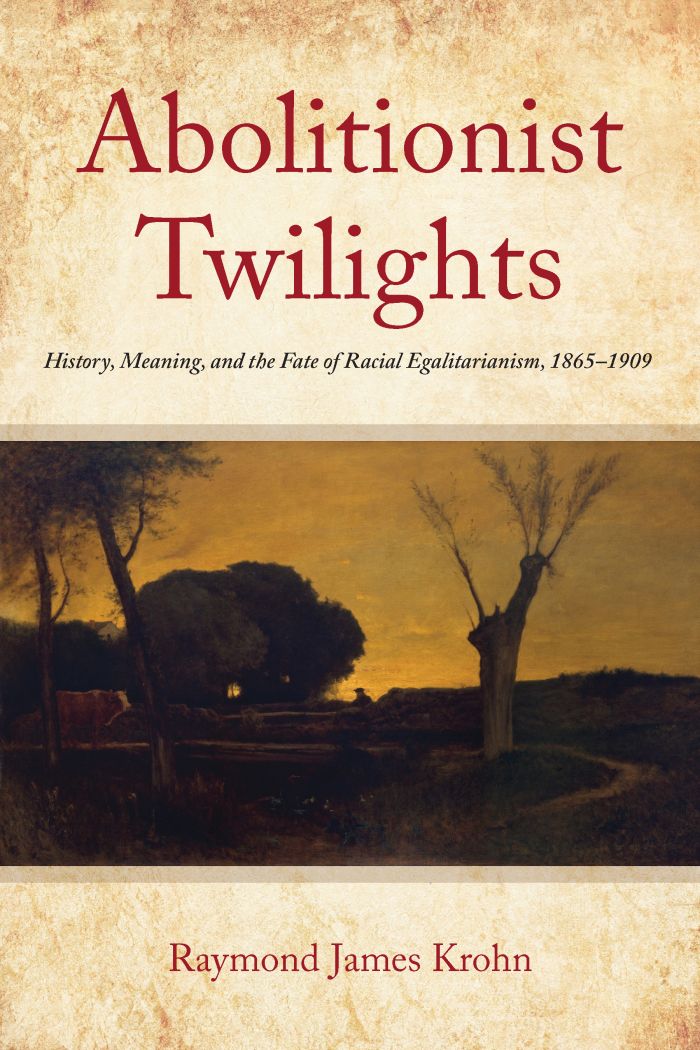Abolitionist Twilights
History, Meaning, and the Fate of Racial Egalitarianism, 1865-1909

This book can be opened with

Provides unique insight into Reconstruction’s downfall and Jim Crow’s emergence.
In the years and decades following the American Civil War, veteran abolitionists actively thought and wrote about the campaign to end enslavement immediately. This study explores the late-in-life reflections of several antislavery memorial and historical writers, evaluating the stable and shifting meanings of antebellum abolitionism amidst dramatic changes in postbellum race relations. By investigating veteran abolitionists as movement chroniclers and commemorators and situating their texts within various contexts, Raymond James Krohn further assesses the humanitarian commitments of activists who had valued themselves as the enslaved people’s steadfast friends.
Never solely against slavery, post-1830 abolitionism challenged widely held anti-Black prejudices as well. Dedicated to emancipating the enslaved and elevating people of color, it equipped adherents with the necessary linguistic resources to wage a valiant, sustained philanthropic fight. Abolitionist Twilights focuses on how the status and condition of the freedpeople and their descendants affected book-length representations of antislavery persons and events. In probing veteran– abolitionist engagement in or disengagement from an ongoing African American freedom struggle, this ambitious volume ultimately problematizes scholarly understandings of abolitionism’s racial justice history and legacy.
Abolitionist Twilights is a must read for intellectual historians of the Civil War era. Krohn provides an in depth analysis of the conceptual limitations that made white abolitionists problematic allies in the years following the war. His book also provides context in the longer narrative of allyship and its shortcomings in the quest for African-American civil rights.—John A. Casey, author of New Men: Reconstructing the Image of the Veteran in Late-Nineteenth-Century American Literature and Culture
. . .Abolitionist Twilights addresses a multidimensional area of scholarship encompassing history, cultural studies, and diversity academia. Krohn's research should help other scholars continue to explore the enduring impacts and transformations of these historical narratives within modern US society.—H-Net Reviews
In the later decades of the nineteenth century, men and women who had spent their antebellum years as part of the abolitionist movement began to devote significant time reflecting on those critical years of the antislavery struggle. . . penning book-length memoirs, sometimes in multiple volumes. In his fascinating new book, Raymond James Krohn examines an array of such publications, providing a meticulous reading of the work of a collection of mostly white abolitionists and helping us to see what this memory work meant for the continuing struggle for Black rights in postbellum America.—Journal of the Civil War Era
Krohn’s Abolitionist Twilights stands as a stark reminder to scholars to consider how the treacherous intersections of memory, nostalgia, and implicit bias often go unquestioned in well-traveled archives. It provides an impressive overview of the literary, autobiographical, and historical legacy of the antislavery movement, and highlights the necessity of further complicating the legacy of abolitionism.—Journal of the Gilded Age and Progressive Era
Introduction: What Is Abolitionism Now?
From the Disposition of the AASS to the Determinants of Abolitionist History | 1
1 Antislavery Moderated: Samuel Joseph May and the Lessons of Respectable Reform | 19
2 Antislavery Elevated: William Wells Brown and the Purpose of Black Activism | 45
3 Antislavery Vindicated: Oliver Johnson and the Value of Abolitionism’s Grand Old Party | 72
4 Antislavery Sanctified: Parker Pillsbury and the Spirit of Abolitionism in the Fields | 100
5 A Tale of Two Slaveries: Aaron Macy Powell and the Transfiguration of Abolitionism | 125
6 Songs of Innocence and Experience: Thomas Wentworth Higginson
and the Abdication of Abolitionism | 154
7 What Was Antislavery For? From the Disbandment of the AASS to
the Determination of Abolitionist Women | 191
Coda: Complicated Legacies | 219
Acknowledgments | 221
Notes | 225
Index | 269




